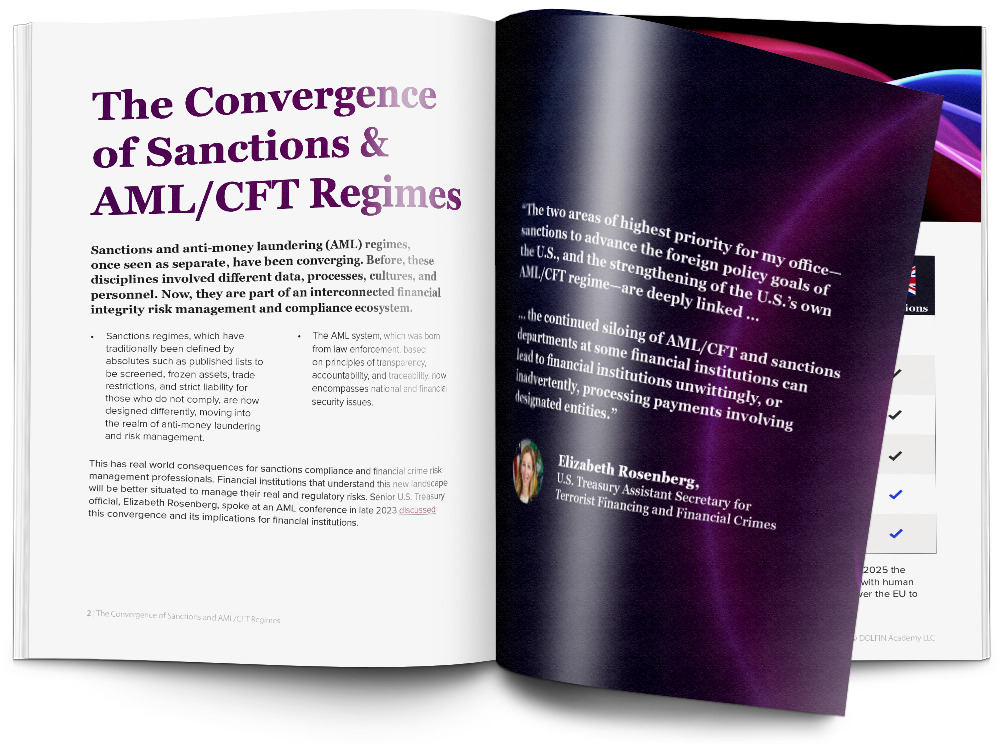Illicit actors and their methodologies do not divide neatly into distinct categories such as “money laundering,” “sanctions evasion,” or “export control evasion.” Instead, the networks involved intersect, establishing the illicit equivalents of service provider relationships, informal alliances, and joint ventures. Similarly, there are commonalities in the methodologies used to advance multiple types of illicit activity, such as the use of shell and front companies.
This is not surprising given that the objectives of money launderers, sanctions evaders, and export control evaders are similar: to obscure the real individuals and entities behind financial activity, to disrupt the transactional trail to make it more difficult to follow, and to avoid detection of the individuals and networks involved.
These convergences not only impact the financial system; they involve adversary states and non-state actors. An integrated approach from regulators and financial institutions to protect financial integrity therefore also directly contributes to defense and national security, enabling organizations to respond strategically to hybrid geopolitical threats.
Russia’s procurement of drone components
In Russia’s ongoing war against Ukraine, drones have emerged as critical weapons. Russia has sought western-made components for their quality and reliability. In 2022, analysis by the UK-based think tank Royal United Services Institute (RUSI) found that of 450 components found in Russian military systems, such as drones, 318 (71 percent) appeared to have been made by U.S. companies, many of them subject to export controls.1
More recently, in 2024, a New York Times investigation found that since Russia’s further invasion of Ukraine 2022, nearly $4 billion in export-controlled semiconductor chips had flowed into Russia from more than 6,000 companies including U.S. manufacturers such as Advanced Micro Devices and Intel.2 In response, OFAC has designated Russian entities and individuals involved in drone and weapon production.3 To support Russia’s illicit procurement activities, shell companies are often used, along with distributors in countries such as China, Hong Kong, Turkey, and India, and transshipment hubs in the UAE, Turkey, and Morocco.
This unlawful acquisition is not just a concern for exporters; the transactions that finance this unlawful trade are often processed through American financial institutions. In July 2024, Denis Postovoy, a Russian national and resident of Sarasota, FL, was charged with procurement and illicit export of microelectronics to Russia.4 The microelectronics had both civil and military applications, including use in drones. U.S.-based companies and distributors of semiconductors and electronic components were also charged.
Banks servicing clients in industries that are at a higher risk of being targeted by illicit procurement networks need to ensure their compliance programs effectively detect and manage the risks.
The U.S. Departments of the Treasury, Commerce, State, and Justice have issued joint advisories with red flags for disrupting illicit procurement networks and abuse of the U.S. financial system.5 These red flags indicate the intersection of money laundering, evasion of export controls and sanctions, and those identified during due diligence, ongoing monitoring, or investigations include:
- Customer received low volumes or no restricted exports prior to February 2022 (Russia’s further invasion of Ukraine and the imposition of sanctions) but restricted exports commence or increase after that date.
- Customer address is on the BIS Entity List (which includes addresses as well as entity names), matches the address of a sanctioned entity, or is associated with money laundering or illicit activity – even if the client entity name is not specifically sanctioned or listed.
- Entities that are newly established shortly after either another company in the same corporate group, or the same associated individuals, were added to a sanctions or export controls list. Update: For more details on the BIS 50% (Affiliates) Rule and how it applies to subsidiaries and related entities, refer to The BIS 50% Rule: Closing a Gap in Our Export Control Defenses.
- As sanctions and export controls have increasing effect, supply chains for Russian weapons and components are increasingly pivoting towards Iran and China.6
Iran’s evasion networks
Iran has strong economic and military ties with both Russia and China. Its role in supplying UAVs to Russia for its war on Ukraine was recognized in a Financial Crimes Enforcement Network (FinCEN) Advisory issued on June 6, 2025.7 Iran sources key components for its UAV program from China, funding them with revenues from oil smuggling and other illicit activities. China is also the largest importer of Iranian oil. As with Russian procurement networks, there are touchpoints with the U.S. financial system, particularly correspondent banks.
In April 2025, the Department of Justice indicted Iranian nationals Hossein Akbari and Reza Amidi, as well as an Iranian company, Rah Roshd Company, for conspiring to procure U.S. technology for use in Iranian UAVs.8 The charges allege that the individuals used front and shell companies to acquire components in Mohajer-6 drones, which are used by Russia against Ukraine. These cases highlight Iranian illicit procurement methodologies, including the use of shell and front companies, links to high risk geographics, and repeated and systematic attempts to evade sanctions. Red flags for financial institutions include:
- The shell companies were based in the UAE, and payments were processed through U.S. correspondent bank accounts.
- Other Iranian procurement networks used front companies based in Hong Kong and China to procure U.S.-origin components used in UAVs in breach of sanctions.9
- When one group of companies is sanctioned, new companies are set up to continue the illicit acquisitions.10
To evade sanctions, Iran also uses third-country exchange houses and trading companies. The exchanges houses convert foreign currency into U.S. dollars, relying on correspondent banking relationships to access the U.S. financial system. The dollars are delivered to regime personnel or proxies outside Iran to facilitate movement of commodities or procurement of restricted components.11 These laundered funds provide the financing for sanctions and export control evasion, as well as being the direct evasion of economic sanctions.
China’s acquisition of restricted chips
China supplies components for Iran’s missile and UAV programs, as described above.12 However, this represents just one focus of China’s procurement and diversion networks. China also seeks high-performance western chips for its own military modernization programs “to improve the speed and accuracy of its military decision making, planning, and logistics, as well as of its autonomous military systems…” and to “improve calculations in weapons design and testing including for WMD [weapons of mass destruction], such as nuclear weapons, hypersonics and other advanced missile systems, and to analyze battlefield effects.”13 One particularly significant application of these chips is their use in Artificial Intelligence (AI).
Chips manufactured using U.S. technology have superior performance, a larger supply, and a more mature software ecosystem compared with chips legally available to Chinese AI labs.14 According to a New York Times investigation in 2025, Chinese State-affiliated entities, including those subject to sanctions, have purchased restricted chips at scale. The investigation identified that of the 136 Chinese companies listed as partners by U.S.-based electronics manufacturer Nvidia, at least 24 have had procurement contracts with the Chinese military or are partly owned by defense contractors or organizations on the BIS Entity List.15
In October 2022, BIS imposed export restrictions specifically focused on advanced chip acquisition by China. Since then, it has imposed additional restrictions and published guidance for industry. For example, in May 2025, BIS published red flags which can potentially be identified by financial institutions during due diligence, ongoing monitoring, or investigations.16 These include:
- Customer that had not received exports of advanced computing chips and/or commodities containing them prior to BIS imposing export restrictions (October 2022) or they received exports but there was a significant increase after October 2022.
- Customers, either domestic or foreign, that have a residential address and provide no alternative location where the advanced computing chips or commodities containing them would be used, and where the quantity is inconsistent with individual/personal use.
- Data center that receives chips or commodities containing them either does not or cannot affirm it has the infrastructure (e.g. power/energy, cooling capacity, or physical space) to operate the advanced computing.
The response: convergence of AML, sanctions, and export control regimes
Leading U.S. regulators responsible for AML (FinCEN), sanctions (OFAC), and export controls (BIS) are collaborating increasingly closely, as demonstrated by a marked increase in joint industry guidance and coordinated administrative and enforcement actions.
Over the past five years the Treasury and Commerce Departments have issued joint guidance documents 15 times on national security and foreign policy issues of mutual concern, often jointly with other relevant agencies. Prior to that there are no such joint Treasury and Commerce guidance documents on record. (See Exhibit 1: Joint Guidance Published by the U.S. Departments of the Treasury and Commerce for the table of joint guidance documents published between July 1, 2020 and May 1, 2025.)
Speaking about how BIS is working with Treasury and other federal agencies, Matt Axelrod, former BIS Assistant Secretary for Export Enforcement stated:
“The cooperation with Treasury has been unprecedented. This is especially true with FinCEN. The joint alerts issued by FinCEN and BIS, which I believe is the first time that FinCEN has released a joint alert with another agency, not only contained the key terms, but also provided red flags for financial institutions to monitor. Additionally, we have released several guidance documents in collaboration with OFAC, and in some cases, jointly with both OFAC and the Department of Justice.”
Enforcement is also increasingly a joint action between U.S. regulators. For example:
- On August 23, 2024, OFAC and BIS announced17 coordinated actions to further disrupt Russia’s international supply chain, counter evasion, and degrade Russia’s wartime economy;
- On January 17, 2025, OFAC and BIS imposed $2.5 million in combined civil penalties against Haas Automation, Inc. for alleged and apparent violations of U.S. sanctions and export control laws;18 and
- On May 1, 2025, OFAC targeted19 a major Mexican cartel involved in fentanyl trafficking and fuel theft concurrent with an alert20 published by FinCEN on oil smuggling schemes associated with Mexico-based cartels.
Exhibit 1 – Joint Guidance Published by the U.S. Departments of the Treasury and Commerce












